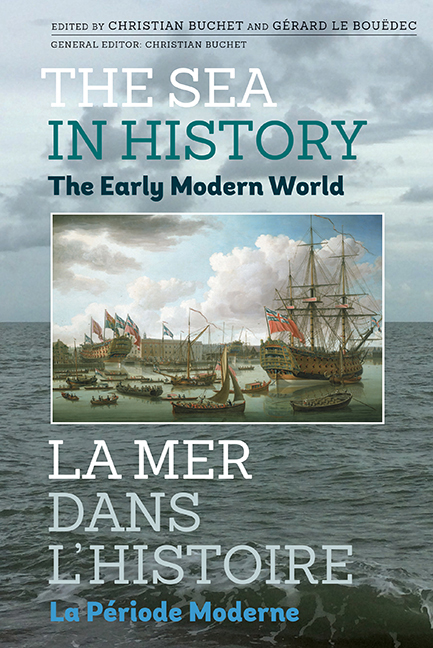Book contents
- Frontmatter
- Contents
- List of Illustrations
- List of Contributors
- Introduction générale et remerciements par
- General introduction and acknowledgements
- Introduction (français)
- Introduction (English)
- LA RÉUSSITE PAR LA MER:La reussite par la mer des territoires et des communautés littorales
- La construction d'un espace mondial: La circulation maritime et les ports
- La forte croissance de l'économie des pêches et des échanges
- Les acteurs de la dynamique maritime
- LA PUISSANCE MARITIME INSTRUMENT DE LA PUISSANCE POLITIQUE ET D'UNE STRATÉGIE GLOBALE DE RAYONNEMENT VOIRE DE DOMINATION: Les puissances maritimes occidentales
- L'océan Indien, entre convoitises et indifférences
- Les puissances maritimes asiatiques
- China's maritime world
- Le Japon et la mer
- Transformation of the maritime world in the Indonesian archipelago
- Corée: les navires garants de la souveraineté
- L'Afrique
- La politique maritime et l'idéologie
- Mer et développement technologique
- Développement maritime et maîtrise économique et financière
- Développement maritime et maîtrise organisationnelle
- Conclusion (français)
- Conclusion (English)
- Conclusion générale par
- General conclusion by
- Miscellaneous Endmatter
- Miscellaneous Endmatter
Le Japon et la mer
from Les puissances maritimes asiatiques
Published online by Cambridge University Press: 11 May 2017
- Frontmatter
- Contents
- List of Illustrations
- List of Contributors
- Introduction générale et remerciements par
- General introduction and acknowledgements
- Introduction (français)
- Introduction (English)
- LA RÉUSSITE PAR LA MER:La reussite par la mer des territoires et des communautés littorales
- La construction d'un espace mondial: La circulation maritime et les ports
- La forte croissance de l'économie des pêches et des échanges
- Les acteurs de la dynamique maritime
- LA PUISSANCE MARITIME INSTRUMENT DE LA PUISSANCE POLITIQUE ET D'UNE STRATÉGIE GLOBALE DE RAYONNEMENT VOIRE DE DOMINATION: Les puissances maritimes occidentales
- L'océan Indien, entre convoitises et indifférences
- Les puissances maritimes asiatiques
- China's maritime world
- Le Japon et la mer
- Transformation of the maritime world in the Indonesian archipelago
- Corée: les navires garants de la souveraineté
- L'Afrique
- La politique maritime et l'idéologie
- Mer et développement technologique
- Développement maritime et maîtrise économique et financière
- Développement maritime et maîtrise organisationnelle
- Conclusion (français)
- Conclusion (English)
- Conclusion générale par
- General conclusion by
- Miscellaneous Endmatter
- Miscellaneous Endmatter
Summary
RÉSUMÉ. L'émergence d'un pouvoir politique unifié dans l'archipel, autour du bakufu, alla de pair avec l'emprise de son autorité sur les mers. En régulant étroitement le commerce extérieur, il mit un terme à l'âge d'or des pirates (wakō), mais contribua à l'isolement du pays en allant jusqu'à interdire aux marchands japonais de construire des navires suffisamment grands pour se rendre à l'étranger. La progression des Japonais en Asie du Sud-Est, qui avait connu un remarquable essor dans la seconde moitié du XVIe siècle, fut, dès lors, stoppée net. Si la mer ne contribua pas de ce fait au rayonnement du Japon, sur la période considérée, au plan international, elle joua un rôle essentiel au plan économique pour avoir été l'aiguillon et le moteur du commerce intérieur. C'est ainsi qu'entre le XVIIe et XIXe siècles, le transport des marchandises du nord au sud de l'archipel connut un essor incroyable, Osaka et Edo endossant le rôle de plaques tournantes. L'apport de la mer ne fut pas non plus sans conséquence au plan idéologique. En ayant pris conscience du contrôle qu'il pouvait exercer sur l'espace maritime, le bakufu intégra plus facilement la notion de souveraineté telle qu'on la concevait en Europe à l'époque moderne. En ce sens, la mer a préparé également le Japon à la modernité.
ABSTRACT. The emergence of a unified political power in the archipelago, around the bakufu, went hand in hand with its extent of authority over the seas. By strictly regulating external trade, it ended the golden age of pirates (wakō) but contributed to the isolation of the country to the extent that Japanese traders were banned from constructing sufficiently large vessels for travel abroad. The progression of the Japanese in Southeast Asia, characterized by a remarkable rise in the second half of the 16th century was from then on stopped short. If consequently the sea did not participate in the influence of Japan over the considered time period internationally, it played an essential role in terms of economics in that it prodded and drove internal trade. Between the 17th and 19th centuries this led to the incredible surge of merchandise transportation from the North to the South of the archipelago, Osaka and Edo taking on the role of hubs. The contribution of the sea did matter in ideological terms.
- Type
- Chapter
- Information
- The Sea in History - The Early Modern World , pp. 564 - 579Publisher: Boydell & BrewerPrint publication year: 2017



